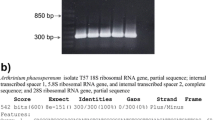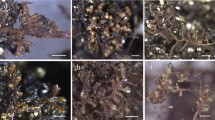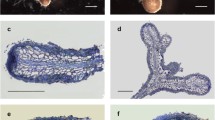Abstract
Two genetically related strains of Tuber borchii Vittad. (1BO and 43BO) produce mycorrhizas with Tilia platyphyllos Scop. with a different degree of efficiency. The aim of this work was to characterize the morphology of the fungal symbiotic structures in order to examine potential relationships between the anatomical traits of the mycorrhiza, the mycorrhizal capacities of the fungal strains and their effect on the host plants. Some morphological features of mantle hyphae (small size, intense staining, vacuolization, abundance of mitochondria) led to a mantle with morphological features that were isolate-specific. There were unexpected differences, at least under our experimental conditions: 1BO strain mantle cells were larger, less reactive to staining, more highly vacuolated and poorer in mitochondria than those of 43BO. These features were found throughout the mantle in 1BO, while the inner mantle hyphae of 43BO were significantly smaller and more intensely stained than the outer cells. In the 43BO strain there was a positive relation between these features and higher infectivity (evaluated as percentage of mycorrhizal tips) as well as a slightly more effective stimulation of plant growth. These observations suggest that genetically related truffle strains produce mycorrhizas with different morphologies, which may be related to a more efficient response of the host plant to inoculation.







Similar content being viewed by others
References
Albrecht C, Burgess T, Dell B, Lapeyrie F (1994) Chitinase and peroxidase activities are induced in Eucalyptus roots according to aggressiveness of Australian ectomycorrhizal strains of Pisolithus sp. New Phytol 127:217–222
Balestrini R, Hahn MG, Faccio A, Mendgen K, Bonfante P (1996) Differential localization of carbohydrate epitopes in plant-cell walls in the presence and absence of arbuscular mycorrhizal fungi. Plant Physiol 111:203–213
Bonfante P, Balestrini R, Martino E, Perotto S, Plassard C, Mousain D (1998) Morphological analysis of early contacts between pine roots and two ectomycorrhizal Suillus strains. Mycorrhiza 8:1–10
Boukcim H, Mousain D (2001) Effects of P-fertilization on the mycorrhization, growth and nutrition (P, N) of Cedrus atlantica Manetti seedlings inoculated in a nursery with mycelia of Tricholoma tridentinum Sing. var. cedretorum Bon. Ann For Sci 58:289–300
Buee M, Rossignol M, Jauneau A, Ranjeva R, Becard G (2000) The pre-symbiotic growth of arbuscular mycorrhizal fungi is induced by a branching factor partially purified from plant root exudates. Mol Plant Microbe Interact 13:693–698
Cairney JWG (1999) Intraspecific physiological variation: implications for understanding functional diversity in ectomycorrhizal fungi. Mycorrhiza 9:125–135
Chalupa V (1984) In vitro propagation of oak (Quercus robur L.) and linden (Tilia cordata Mill.). Biol Plant 26:374–377
Eissenstat D (2000) Root structure and function in an ecological context. New Phytol 148:353–354
Giomaro G, Zambonelli A, Sisti D, Cecchini M, Evangelista V, Stocchi V (2000) Anatomical and morphological characterization of mycorrhizas of five strains of Tuber borchii Vittad. Mycorrhiza 10:107–114
Gow NAR, Gadd GM (1995) The growing fungus. Chapman & Hall, London, pp 1–473
Harrison MJ (1999) Molecular and cellular aspects of the arbuscular mycorrhizal symbiosis. Annu Rev Plant Physiol Plant Mol Biol 50:361–389
Horton TR, Bruns TD (2001) The molecular revolution in ectomycorrhizal ecology: peeking into the black-box. Mol Ecol 10:1855–1871
Martin F (2001) Frontiers in molecular mycorrhizal research-genes, loci, dots and spins. New Phytol 150:499–505
Marx DH (1969) Influence of ectotrophic mycorrhizal fungi on the resistance of pine roots to pathogenic infections. II. Production, identification, and biological activity of antibiotics produced by Leucopaxillus cerealis. Phytopathology 59:411–417
Molina R (1979) Pure culture synthesis and host specificity of red alder mycorrhizae. Can J Bot 57:1223–1228
Murashige T, Skoog FB (1962) A revised medium for rapid growth and bioassay with tobacco tissue cultures. Physiol Plant 15:473–497
Peterson RL, Bonfante P (1994) Comparative structure of vesicular-arbuscular mycorrhizas and ectomycorrhizas. Plant Soil 159:79–88
Roland JC, Vian B (1991) General preparation and staining of thin sections. In: Hall JL, Hawes C (eds) Electron microscopy of plant cells. Cambridge University Press, Cambridge, pp 1–66
Rossi I, Zeppa S, Potenza L, Sisti D, Zambonelli A, Stocchi V (1999) Intraspecific polymorphisms among Tuber borchii Vittad. mycelial strains. Symbiosis 26:313–325
Sisti D, Zambonelli A, Giomaro G, Rossi I, Ceccaroli P, Citterio B, Benedetti PA, Stocchi V (1998) In vitro mycorrhizal synthesis of micropropagated Tilia platyphyllos Scop. plantlets with Tuber borchii Vittad. mycelium in pure culture. Acta Hortic 457:379–384
Smith SE, Read DJ (1997) Mycorrhizal symbiosis. Academic, London, 1–605
Sokal RR, Rohlf FJ (1995) Biometry. Freeman, New York
Van der Heijden MGA, Klironomos JN, Ursic M, Moutoglis P, Streitwolf-Engel R, Boller T, Wiemken A, Sanders IR (1998) Mycorrhizal fungal diversity determines plant biodiversity, ecosystem variability and productivity. Nature 396:69–72
Wahl S, Ryser P (2000) Root tissue structure is linked to ecological strategies of grasses. New Phytol 148:459–471
Zambonelli A, Salomoni S, Pisi A (1995) Caratterizzazione anatomo-morfologica delle micorrize di Tuber borchii, Tuber aestivum, Tuber mesentericum, Tuber brumale, Tuber melanosporum su Pinus pinea. Micol Ital 24:119–137
Acknowledgements
The work of P.B. and G.G. was funded by Special Project "Biotecnologia della micorrizazione" and Target Project "Biotechnology", C.N.R. We thank Dr. A. Zambonelli for the isolation of fungal strains.
Author information
Authors and Affiliations
Corresponding author
Rights and permissions
About this article
Cite this article
Sisti, D., Giomaro, G., Cecchini, M. et al. Two genetically related strains of Tuber borchii produce Tilia mycorrhizas with different morphological traits. Mycorrhiza 13, 107–115 (2003). https://doi.org/10.1007/s00572-002-0220-7
Received:
Accepted:
Published:
Issue Date:
DOI: https://doi.org/10.1007/s00572-002-0220-7




